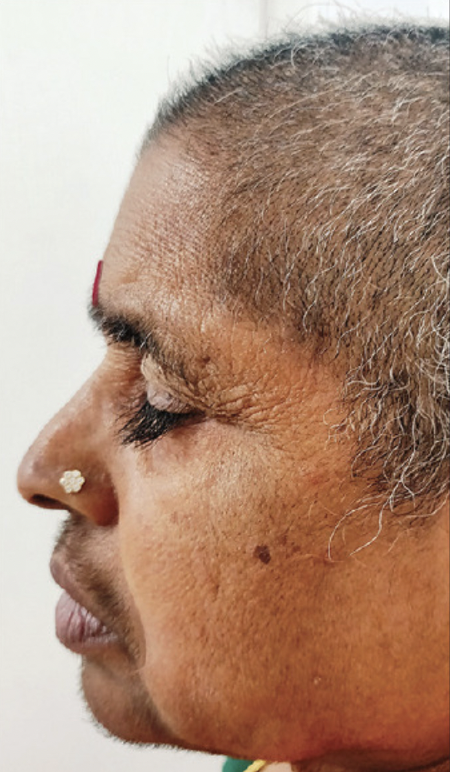Eyelash Trichomegaly: A Closer Look at Eyelash Hypertrichosis
A Review of Eyelash Trichomegaly.
Trichomegaly is defined as an increase in the length (above 12 mm), thickness, stiffness, curling, and pigmentation of existing eyelashes. The term “trichomegaly” was first used by Gray in 1944.
Trichomegaly (longer eyelashes) and hypertrichosis in a patient receiving The EGFR inhibitor chemotherapy medication Erlotinib. Inamadar S and Kumar NSP. Lady with Long Eyelashes… Int J Trichology. Mar-Apr 2022;14(2):71-72. Image shown with creative commons license.
It is important to understand some of the common conditions associated with trichomegaly as this will guide history taking, physical examination and work up. A patient with trichomegaly associated with glaucoma eyedrops may not need any workup. A patient with trichomegaly associated with fatigue, muscle weakness, weight loss, or rashes may require a detailed work up by various specialist.
GENETIC SYNDROMES
Oliver-McFarlane syndrome
Oculocutaneous albinism type I
Familial hypertrichosis
Cornelia de Lange Syndrome
Cone—rod dystrophy
Tetralogy of Fallot
Hermansky Pudlak syndrome
Familial Trichomegaly
Goldstein Hutt Syndrome
Costello Syndrome
Phylloid hypomelanosis
Smith-Magenis Syndrome
Cantú syndrome
CHOPS syndrome
Coffin-Siris syndrome
Cornelia de Lange syndrome
Floating Harbor syndrome
Kabuki-Makeup syndrome
KBG syndrome
Rubinstein-Taybi syndrome
TOPICAL MEDICATIONS
topical latanoprost, bimatoprost and travoprost (**most commonly reported causes)
topical cyclosporine
topical tacrolimus
ORAL MEDICATIONS
oral zidovudine (HIV medication)
oral topiramate
oral cyclosporine
oral tacrolimus
Interferon-α2b
Corticosteroids
Penicillamine
EGFR inhibitors (cetuximab, erlotinib, gefitinib, panitumumab)
FGFR inhibitors Pemigatinib
Streptomycin
Acetazolamide
Diazoxide
Minoxidil
Psoralens
Vismodegib
SYSTEMIC CONDITIONS
HIV type 1 (often late stage)
Uveitis
Vernal keratoconjunctivitis
Dermatomyositis
Systemic lupus erythematosus
Paraneoplastic acquired hypertrichosis lanuginosa (renal cell cancer, lung cancer etc)
Anorexia
Atopic dermatitis
Allergic rhinitis
Hypothyroidism
Pregnancy
Alopecia areata
Malnutrition
Porphyrias
Work up and Management
The work up and evaluation of patients with trichomegaly will depend on the information obtained from the history and the physical examination. History taking must involve inquiry into medication use, medical conditions, family history, syndrome features, past surgeries and complete review of system systems (a head to toe review of organ associated features including fatigue, headaches, seizures, rashes, eye symptoms, difficulty swallowing, shortness of breath, chest pain, diarrhea, vomiting, muscle weakness, joint pains, back pain, menstrual cycles in women, skin rashes, sneezing, rhinorrea). HIV history should be obtained as appropriate. Hair growth or loss in other areas of the body must be ascertained. Pregnancy in women must be considered.
Examination should include careful evaluation of the eyelashes for symmetry and length and distribution (even growth or patchy growth). The eye should be examined for immediate evidence of redness, conjunctivitis or trichiasis. Generally speaking, all patients with trichomegaly and eye symptoms or cursory eye signs need immediate referral to the eye doctor to rule out corneal irritation or scarring.
Examination should proceed with evaluation for hypertrichosis in other areas of the body including face, arms, legs and adbomen. The skin should be examined for rashes as well as other dermatologic manifestations. A physical examination should be conducted by a general practitioner or interest if there are any concerns for a systemic cause. Concerns for a systemic cause will depend on the answer to questions posed during history taking.
Trichomegaly often occurs within a few months of starting treatment. It is reversible once the drugs are stopped. Trichomegaly can be associated with an increased risk of eye infection and secondary corneal ulcerations from trichiasis. For this reasons, patients with trichomegaly who have eye symptoms should be referred to an eye doctor for full review. Trimming the eyelashes is a satisfactory treatment for most patients although surgery and other means to control eyelash growth may be needed.
REFERENCE
Kaur S et al. Eyelash Trichomegaly. Indian J Dermatol. 2015 Jul-Aug; 60(4): 378–380.
Koksal UI et al. Trichomegaly Induced by Cetuximab: Case Series and Review the Literature. Am J Ther. 2016 Sep-Oct;23(5):e1226-9. doi:
Hutchison DM et al. Eyelash trichomegaly: a systematic review of acquired and congenital aetiologies of lengthened lashes. .J Eur Acad Dermatol Venereol. 2022 Apr;36(4):536-546.
Paul LJ et al. Eyelash trichomegaly: review of congenital, acquired, and drug-associated etiologies for elongation of the eyelashes. Int J Dermatol. 2012 Jun;51(6):631-46; quiz 643-4, 64
Freites-Martinez A et al. Hair disorders in patients with cancer. J Am Acad Dermatol. 2019 May;80(5):1179-1196.
This article was written by Dr. Jeff Donovan, a Canadian and US board certified dermatologist specializing exclusively in hair loss.

